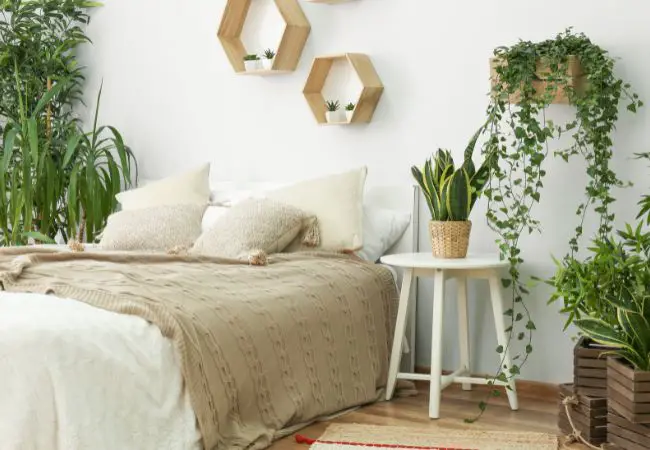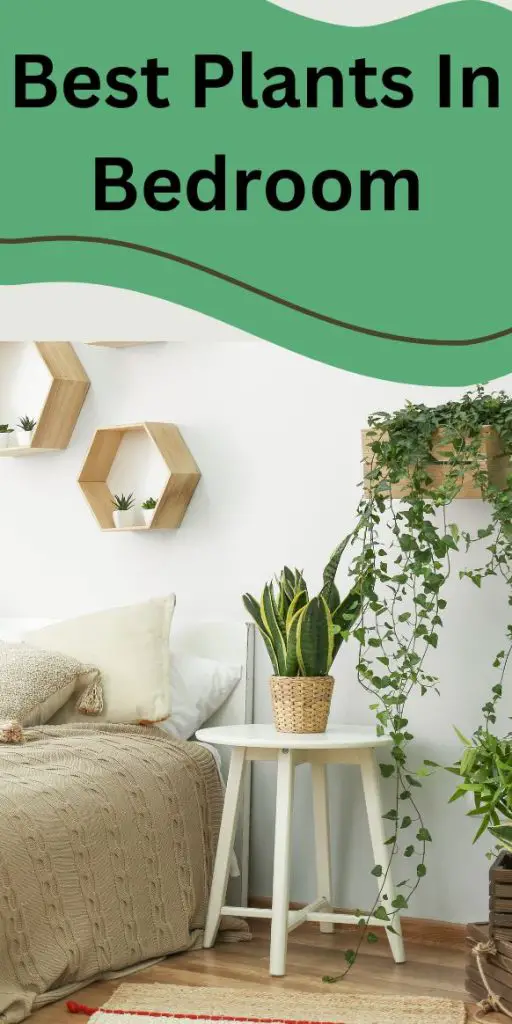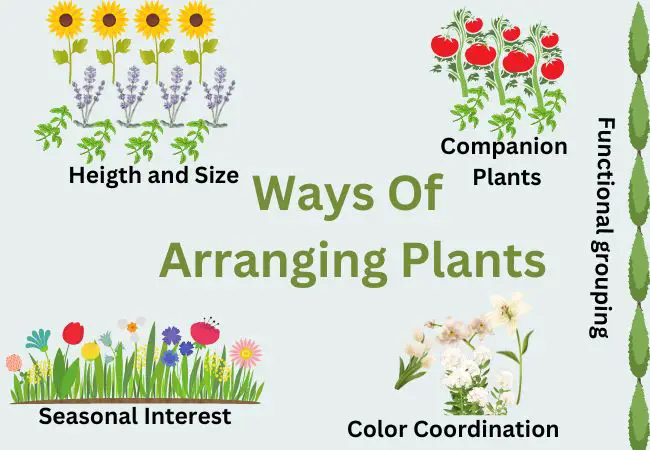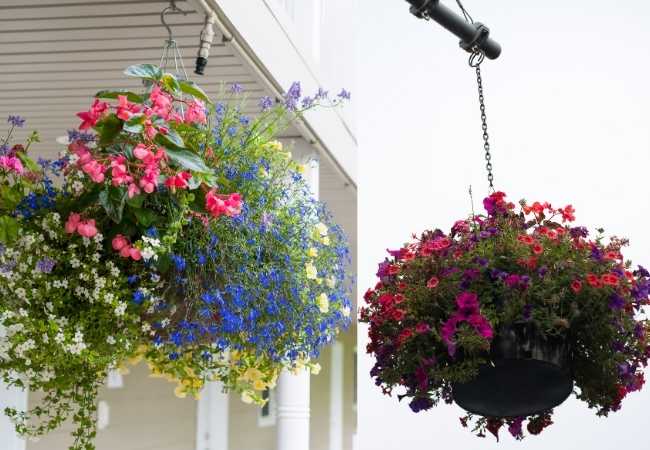Best Bedroom Plants for Sleep and Ambiance

These are the best bedroom plants for sleep and ambiance. Your bedroom is more than just a place to rest your weary head at the end of the day. It’s your sanctuary, your haven where you seek solace and rejuvenation.
Best Bedroom Plants for Sleep and Ambiance
Creating a calming and tranquil atmosphere is essential for a good night’s sleep, and one way to achieve that is by incorporating indoor plants into your bedroom decor.
Not only do they add a touch of natural beauty, but they also provide numerous benefits that promote relaxation and better sleep.
In this post, I will explore the best bedroom plants and their unique qualities that I love that make them the perfect companions for my sleep sanctuary.
Factors to Consider when Choosing Bedroom Plants
There are very many houseplants that you can move into your bedroom. These are the factors you should consider when deciding which ones to move to your bedroom.
Lighting requirements
Different plants have varying lighting needs. Consider the amount of natural light your bedroom receives and choose plants accordingly.
Low-light plants like Snake Plants thrive in dimly lit spaces, while others like Aloe Vera and Spider Plants prefer bright, indirect light. If your bedroom is dark, check out this post on the best plants for dark spaces.
Temperature and humidity preferences
Maintaining a comfortable temperature and humidity level is vital for both your plants and your sleep.
Some plants, like Peace Lilies, thrive in average room temperatures, while others, like English Ivy, prefer cooler temperatures. It’s important to select plants that can adapt to the climate of your bedroom.
Allergies and sensitivities
If you have allergies or sensitivities, it’s crucial to choose plants that won’t trigger any adverse reactions.
Plants like Snake Plants and Aloe Vera are known for their hypoallergenic properties, making them safe choices for allergy sufferers.
While plants that flower and produce pollen are not ideal for people with allergies.
Maintenance and care level
Consider the amount of time and effort you’re willing to invest in plant care. Some plants, such as Spider Plants and Snake Plants, are low-maintenance and require minimal attention, while others may need more frequent watering, fertilization, or pruning.
Top 5 Best Bedroom Plants
These are my top five plants that I have found that work well in my bedroom space and would therefore recommend them.
Snake Plant (Sansevieria trifasciata):
The Snake Plant, also known as Mother-in-Law’s Tongue, is a popular choice for bedroom plants. It has striking tall, sword-like leaves that add an elegant touch to any space.
Snake Plants are low maintenance and possess excellent air-purifying qualities, removing toxins like formaldehyde and benzene from the air.
Peace Lily (Spathiphyllum)
With its graceful white flowers, the Peace Lily brings a sense of serenity to your bedroom. This plant not only enhances aesthetics but also improves indoor air quality by filtering harmful pollutants.
Additionally, Peace Lilies release moisture into the air, increasing humidity and combating dryness.
Spider Plant (Chlorophytum comosum)
The Spider Plant is a versatile and resilient plant that thrives in various conditions, making it ideal for beginners. It not only adds a touch of greenery but also acts as a natural air purifier, removing toxins such as formaldehyde and xylene.
Spider Plants also produce “baby” plants, known as spiderettes, which can be propagated and shared with friends.
I love spider plants in the bedroom because I can put them in hanging baskets and they look beautiful cascading from the sides.
Aloe Vera (Aloe barbadensis)
Aloe Vera is a popular succulent known for its healing properties. It releases oxygen at night, making it an excellent choice for bedrooms.
Apart from its air-purifying qualities, Aloe Vera gel is widely used for its soothing effects on the skin, making it a multi-purpose plant for your sleep sanctuary.
English Ivy (Hedera helix)
If you’re looking for a plant that adds an enchanting touch to your bedroom, English Ivy is a perfect choice. It’s known for its cascading foliage, creating a calming and romantic atmosphere.
English Ivy is also effective in reducing airborne mold and various pollutants, promoting cleaner air.
Tips for Placing and Caring for Bedroom Plants
You don’t want dead or dying plants in your bedroom. Not only do they look unappealing but they also bring negative vibes. These are some of the tips I follow to keep my bedroom plants thriving and healthy.
Ideal locations for plants in the bedroom
Place plants near windows to ensure they receive adequate light.
Consider placing plants on bedside tables, or shelves, or hanging them from the ceiling to maximize space.
Watering and fertilization guidelines
Follow the watering instructions specific to each plant. Avoid overwatering, as it can lead to root rot.
Use a well-draining potting mix to prevent waterlogging. Fertilize plants regularly during the growing season to promote healthy growth.
Common plant care mistakes to avoid
- Avoid exposing plants to extreme temperatures or drafts.
- Monitor the humidity levels in your bedroom and adjust accordingly.
- Trim yellow or dead leaves to maintain the plant’s appearance and health.
- Regularly dust the leaves to keep them clean and allow for optimal photosynthesis.
Regular cleaning and dusting of leaves
Dust can accumulate on plant leaves, hindering their ability to absorb light. This can be a great concern for bedroom plants because they are already growing in a space with less-than-ideal light.
Gently wipe the leaves with a damp cloth or mist them with water to remove dust. This not only keeps the plants looking fresh but also helps them function optimally.
Common Concerns and Myths about Bedroom Plants
Oxygen and carbon dioxide exchange during the night:
While plants produce oxygen during the day through photosynthesis, they also respire and release carbon dioxide at night.
The amount of carbon dioxide released by plants at night is minimal and poses no harm to humans.
Plants can still contribute to better air quality by filtering toxins and releasing oxygen during the day.
Potential allergens and reactions
Some individuals may be sensitive to certain plant allergens, such as pollen or sap.
Select plants with low allergy potential, like Snake Plants or Aloe Vera, if you have known sensitivities. Regularly clean the leaves to remove potential dust allergens.
Safety considerations (pet and child-friendly options)
Some plants can be toxic to pets or children if ingested. Choose non-toxic plants like Spider Plants or Boston Ferns if you have pets or small children.
If this is a big concern for you, keep plants out of reach or use hanging planters to prevent accidental ingestion.
Final Thoughts on Bedroom Plants
I love incorporating indoor plants into my bedroom to transform it into a serene and peaceful sleep sanctuary. From air purification and humidity regulation to aesthetic enhancement, the best bedroom plants offer numerous benefits.
Consider factors such as lighting, temperature, and maintenance when choosing plants for your bedroom. The Snake Plant, Peace Lily, Spider Plant, Aloe Vera, and English Ivy are among my top choices for their unique qualities.
By following placement and care tips, you can enjoy the beauty and benefits of bedroom plants while creating a tranquil space conducive to restful sleep.
I hope this post on the best bedroom plants for sleep and ambiance helps to go ahead and bring nature indoors to enhance your sleep sanctuary.
If you love gardening and all things to do with houseplants and flowers, please follow me on Multigardening Pinterest for more awesome posts.






